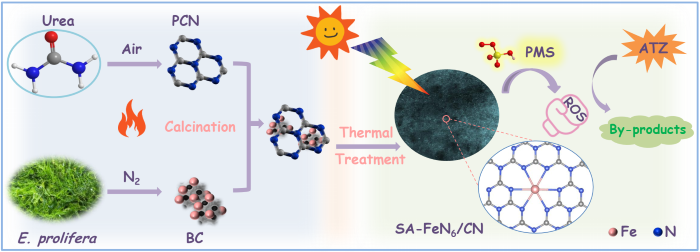
Links
Turning trash into treasure: Enteromorpha prolifera derived single-atom catalysts promote efficient degradation of herbicide
Recently, researchers from Institute of Tobacco Research, Chinese Academy of Agricultural Sciences (TRI, CAAS) fabricated Fe single-atom catalysts (SACs) via Enteromorpha prolifera (E. prolifera) for atrazine (ATZ) degradation. Results unveiled the catalyst structure-photocatalytic peroxymonosulfate activation performance relationship, offering avenue for developing more sustainable and efficient biomass-derived SACs for herbicide treatment. The related research findings have been published in Chemical Engineering Journal.
ATZ has been increasingly criticized for its adverse effects on the environment and public health. More cost-effective, easily synthesized, and non-toxic catalysts are required for ATZ degradation. E. prolifera is the main green algae causing seasonal seawater pollutant, and it is recorded to have the highest content of Fe (0.2–0.5 wt%) in algae. Preparing SACs using biomass as a metal source with uncontrollable coordination structures is still challenging.
In this study, a copyrolysis strategy was employed to synthesize Fe SACs with varying Fe–NX coordination, i.e., Fe–N5 and Fe–N6, using E. prolifera. Fe–N6-based SAC achieved over 80% ATZ degradation in 15 min, with a degradation rate of 0.13 min-1, representing 2.6-fold improvement over SAC with Fe–N5 structure. Experimental and simulation results revealed that Fe–N6 active sites acted as electron donors, enhancing the delocalization of π-electrons and improving photocatalytic peroxymonosulfate activation. This SAC also exhibited high selectivity for 1O2 degradation pathway and impressive ATZ degradation in seawater, with notable chlorine resistance. The research offers a new approach for the effective control of pesticide residues and the potential utilization of biomass.
The research was carried out jointly with researchers at Jiangsu University and The University of Adelaide. The research was funded by the National Natural Science Foundation of China, the Fundamental Research Funds for Central Non-profit Scientific Institution, and the Agricultural Science and Technology Innovation Program.

Original link:
https://www.sciencedirect.com/science/article/pii/S1385894724081166